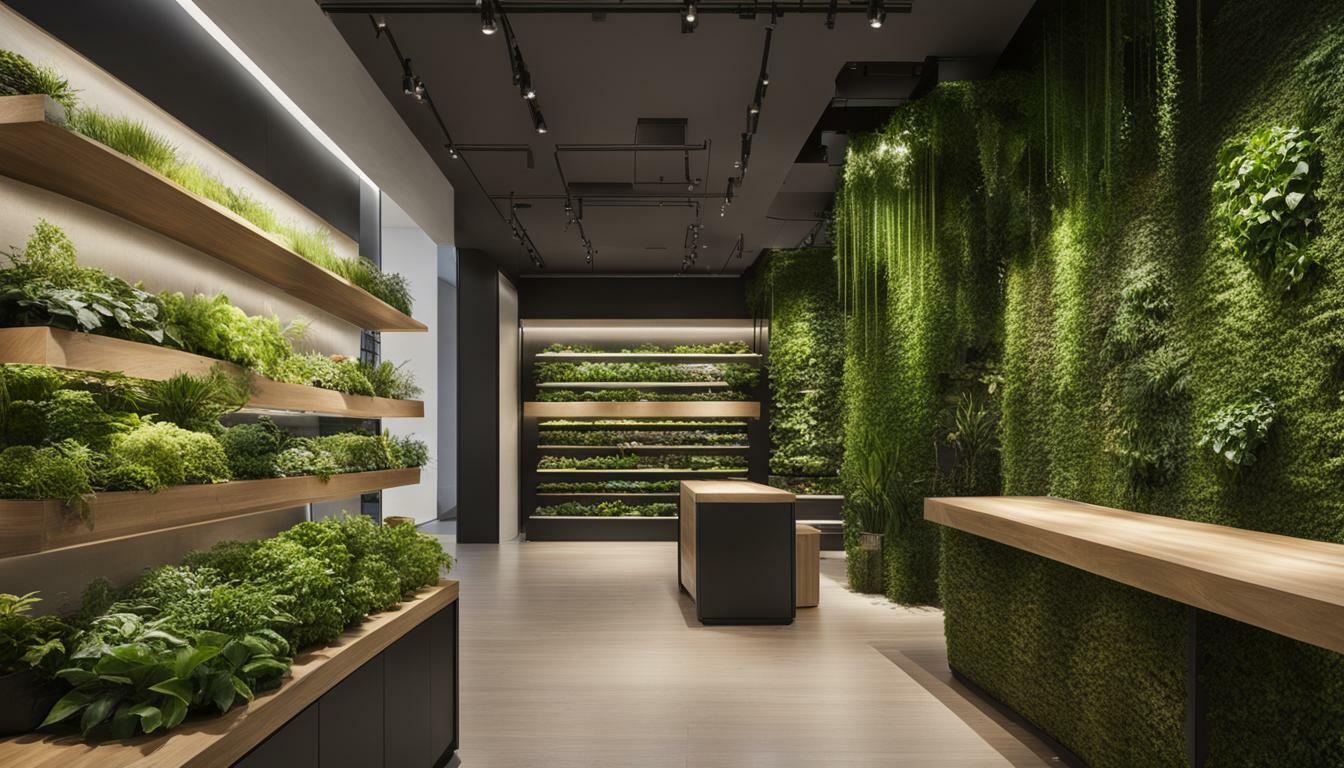Welcome to our article on premier vertical garden supply for top-notch green spaces. Discover how our high-quality products can transform your spaces into lush, vibrant environments. With our vertical garden supply, you can create stunning green walls and plant walls that not only beautify your surroundings but also offer a multitude of benefits. From maximizing space to improving air quality, vertical gardens are a fantastic addition to any home or outdoor area.
Key Takeaways:
- Vertical gardens maximize space and create focal points in any environment.
- They improve air quality, reduce noise pollution, and provide natural humidity.
- Choosing the right location, containers, and plants are essential for planning a successful vertical garden.
- Regular maintenance, including proper watering, fertilizing, and pruning, is necessary for the health of your vertical garden.
- Building a vertical garden is a step-by-step process that requires the right materials and installation techniques.
- Considerations such as size, materials, and functionality are important when choosing the right vertical garden system.
- Vertical gardens offer endless design possibilities and customization options.
- They are perfect for small spaces like urban environments and balconies.
- Sustainable practices, including using recycled materials and eco-friendly techniques, are important in vertical gardening.
- Maintaining a vertical garden requires monitoring moisture levels, fertilizing, and regular pruning.
- Explore unique and creative vertical garden ideas to inspire your own green space.
Benefits of Vertical Garden Building
Building a vertical garden comes with a multitude of benefits that can enhance your outdoor space and create a visually stunning green oasis. Vertical gardens, also known as green walls or plant walls, maximize vertical space to transform otherwise unused areas into flourishing gardens. Here are some key advantages of vertical garden building:1. Maximizing Space: Vertical gardens are ideal for limited spaces like balconies, fences, or indoor areas. They allow you to make the most of your available space by utilizing vertical surfaces, giving you the opportunity to grow a variety of plants even in small areas.2. Improving Air Quality: Vertical gardens not only add beauty to your surroundings but also help improve air quality. They act as natural air filters by increasing oxygen levels and reducing pollutants like volatile organic compounds (VOCs) and carbon dioxide, creating a healthier environment.3. Creating a Focal Point: Vertical gardens serve as focal points, adding visual interest and enhancing the aesthetics of your outdoor space. With the right choice of plants and design, they can become stunning pieces of living art that catch the eye and create a unique ambiance.4. Increasing Biodiversity: Vertical gardens attract a wide range of beneficial insects, birds, and butterflies, contributing to biodiversity in urban environments. By providing habitat and food sources, they help support local ecosystems and promote a more sustainable environment.5. Stress Reduction: Being surrounded by greenery has been proven to reduce stress levels and improve mental well-being. Vertical gardens provide a calming and relaxing atmosphere, creating a peaceful retreat in both outdoor and indoor spaces.Incorporating these benefits into your garden design can enhance your outdoor experience and bring nature closer to your daily life.Table: Vertical Garden Benefits
| Benefits | Description |
|---|---|
| Maximizing Space | Utilize vertical surfaces to grow plants in limited areas |
| Improving Air Quality | Act as natural air filters, increasing oxygen and reducing pollutants |
| Creating a Focal Point | Add visual interest and enhance the aesthetics of outdoor spaces |
| Increasing Biodiversity | Attract beneficial insects and support local ecosystems |
| Stress Reduction | Create a calming and relaxing environment |
“Vertical gardens serve as focal points, adding visual interest and enhancing the aesthetics of your outdoor space.”So why wait? Start planning and building your own vertical garden to transform your outdoor space into a lush, green oasis.
How to Plan Your Vertical Garden
Proper planning is essential when embarking on a vertical garden project. By carefully considering factors such as location, containers, and plant selection, you can create a thriving green space.
Choosing a Location:
When planning your vertical garden, it is crucial to choose the right location. Take into account the amount of sunlight available, wind exposure, and access to water. Aim for a location that receives at least six hours of direct sunlight each day. Balconies or fences are ideal spots for vertical gardens, as they offer ample vertical space and can help your plants thrive.
Choose the Right Containers:
Selecting the appropriate containers is key to the success of your vertical garden. Opt for lightweight, durable vertical garden planters that provide enough space for root growth and proper drainage. Good container choices include vertical garden systems that come with built-in planters or individual pots that can be easily attached to a vertical support structure.
Choose the Right Plants:
When choosing plants for your vertical garden, consider their suitability for vertical growth. Smaller plants, such as herbs, fit well in vertical gardens. Trailing plants like ivy create beautiful cascading effects, while flowering plants add vibrant colors. Ensure that the plants you select can thrive in your chosen location and are compatible with vertical gardening conditions.
| Factors to Consider for Vertical Garden Planning | Location | Containers | Plants |
|---|---|---|---|
| Guidelines | Choose a spot with at least six hours of direct sunlight. | Opt for lightweight, durable, and well-draining containers. | Select small plants suitable for vertical growth. |
| Benefits | Maximizes vertical space and creates a focal point. | Provides root growth space and proper drainage. | Adds visual interest and vibrant colors to your vertical garden. |
Proper planning and consideration of location, containers, and plant selection are essential for creating a successful and thriving vertical garden. By following these guidelines, you can enjoy the beauty of a vibrant green space, no matter how limited your gardening area may be.
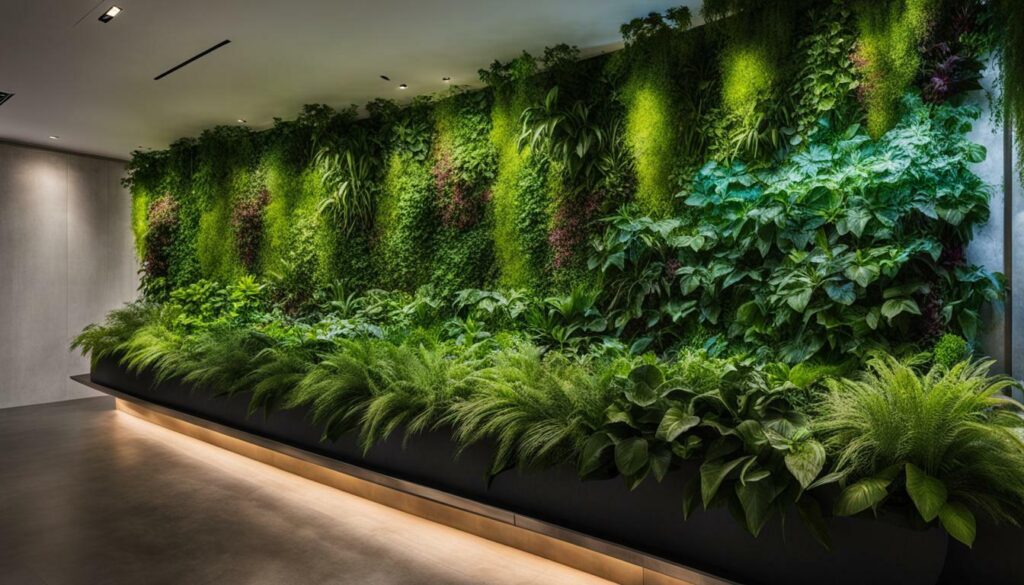
Now that you have planned your vertical garden, it’s time to learn about how to maintain it. In the next section, we will provide tips and advice on how to keep your vertical garden healthy and flourishing.
How to Maintain Your Vertical Garden
To ensure the ongoing health and success of your vertical garden, regular maintenance is crucial. Learn how to properly care for your plants to keep them thriving.
Watering your vertical garden is one of the most important maintenance tasks. Monitor the moisture levels of the soil and water accordingly. Vertical garden walls may require more frequent watering than traditional gardens due to their vertical orientation.
When fertilizing your plants, opt for organic or slow-release fertilizers to provide essential nutrients. This will help promote healthy growth and ensure your plants thrive. Follow the manufacturer’s instructions for application rates and frequency.
Pruning is another critical maintenance task for vertical gardens. Regularly inspect your plants and remove any dead or wilted leaves. Trim overgrown branches to prevent overcrowding and promote healthier growth. This will help maintain the overall appearance and health of your vertical garden.
Vertical Garden Maintenance Tips
Here are some additional vertical garden maintenance tips to keep your green space in prime condition:
- Monitor for pests and take appropriate measures to control them.
- Regularly check the nutrient levels of the soil and adjust fertilization as needed.
- Ensure proper drainage to prevent waterlogging and root rot.
- Inspect the vertical structure for stability and make any necessary adjustments or repairs.
Maintaining a thriving vertical garden requires consistent care and attention. By following these maintenance tips, you can ensure your green space remains vibrant and healthy.

Steps to Building a Vertical Garden
Ready to start building your own vertical garden? Follow these step-by-step instructions to create a stunning green wall in your desired space.
Step 1: Choose Your Location
The first step in building a vertical garden is selecting the perfect location. Consider the amount of sunlight your plants will receive and the accessibility to water. Ideally, your vertical garden should be placed in an area that receives at least six hours of direct sunlight. Balconies, fences, or indoor walls are great options.
Step 2: Select the Right Containers
Once you have chosen your location, it’s time to select the right containers for your vertical garden. Opt for lightweight and durable vertical garden planters that provide enough space for root growth and proper drainage. Consider using hanging pots, wall-mounted planters, or pocket planters.
Step 3: Choose the Right Plants
When selecting plants for your vertical garden, choose varieties that are suitable for vertical gardening. Opt for smaller plants that have shallow roots and can thrive in limited space. Herbs like basil, mint, and rosemary are excellent choices, as well as trailing plants like ivy or colorful flowering plants.
Step 4: Install Your Vertical Garden
Now it’s time to install your vertical garden. Start by mounting your containers onto the chosen wall or structure using appropriate hardware or hooks. Ensure that the containers are securely attached and evenly spaced. You can arrange them in a creative pattern or follow a more structured design.
For a step-by-step visual guide on installing your vertical garden, refer to this video tutorial: [embedded content]![]()
Step 5: Plant and Maintain Your Garden
Finally, it’s time to plant your chosen plants in the containers and start enjoying your vertical garden. Ensure that each plant has enough room to grow and that the soil is moist and well-drained. Regularly water and fertilize your vertical garden to promote healthy growth. Don’t forget to regularly prune and trim your plants to maintain their shape and prevent overcrowding.
| Step | Description |
|---|---|
| Step 1 | Choose Your Location |
| Step 2 | Select the Right Containers |
| Step 3 | Choose the Right Plants |
| Step 4 | Install Your Vertical Garden |
| Step 5 | Plant and Maintain Your Garden |
With these simple steps, you can create a stunning vertical garden that adds beauty and greenery to any space. Enjoy the process of building and maintaining your own green oasis!
Choose the Right Vertical Garden System
When choosing a vertical garden system, it’s important to consider various factors to ensure you select the right one for your specific needs and preferences. Here are some key considerations:
- Size: Determine the size of the vertical garden system that will fit your available space. Consider the height, width, and depth of the system to ensure it can accommodate the number of plants you want to grow.
- Materials: Look for vertical garden systems made from durable and weather-resistant materials such as plastic, metal, or wood. Consider the overall quality and lifespan of the materials used.
- Functionality: Consider the functionality of the vertical garden system. Does it provide proper drainage for excess water? Does it allow for proper airflow and ventilation to prevent plant diseases? Choose a system that meets your specific needs.
- Customization: Some vertical garden systems offer customization options, allowing you to adjust the layout or configuration to suit your preferences. Consider whether you want the flexibility to change the arrangement of your plants over time.
By carefully considering these factors, you can choose a vertical garden system that meets your needs and ensures a successful growing experience.
Comparison of Popular Vertical Garden Systems
Here is a comparison table of some popular vertical garden systems to help you make an informed decision:
| Vertical Garden System | Size | Materials | Functionality | Customization |
|---|---|---|---|---|
| The Varden™ Vertical Garden | Various sizes available | Recycled plastic | Efficient drip irrigation system | Customizable layout |
| GreenStalk Original Vertical Planter | 19” wide x 55” tall | Food-grade, UV-resistant plastic | Top water reservoir for easier watering | Stackable up to 5 tiers |
| DIY Vertical Garden | Customizable based on materials used | Depends on materials used | Depends on design and construction | Depends on design and construction |
These are just a few examples of vertical garden systems available in the market. Consider your specific needs and preferences, and research different options to find the one that is best suited for your vertical gardening project.
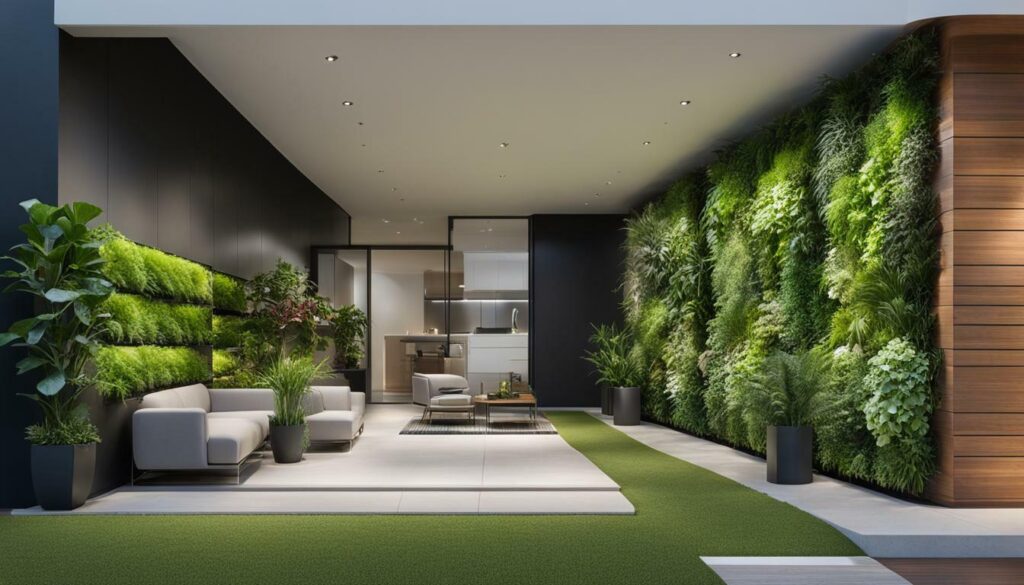
Remember, choosing the right vertical garden system is crucial for the success of your green space. Take the time to evaluate different options, consider the factors that matter most to you, and select a system that will help you create a thriving and visually appealing vertical garden.
Explore Different Vertical Garden Designs
Get inspired by exploring various vertical garden designs that can turn any space into a stunning and personalized green oasis. Whether you have a small balcony or a large backyard, there are endless possibilities to create a unique and eye-catching vertical garden.
One popular design option is a living wall, where plants are arranged in a grid-like pattern on a vertical surface. This design creates a striking visual impact and can be customized with different plant varieties to create a colorful and textured display. Living walls are perfect for both indoor and outdoor spaces, adding a touch of nature and beauty to any environment.
If you’re looking to add a touch of creativity to your vertical garden, consider incorporating unique installations. This could include hanging planters, suspended pots, or even repurposed materials like old pallets or crates. These unconventional designs add a touch of whimsy and allow for a personalized and artistic expression of your green space.
Customization Options:
| Design Option | Description |
|---|---|
| Living Walls | Plants arranged in a grid-like pattern on a vertical surface. |
| Hanging Planters | Pots suspended from above, creating a cascading effect. |
| Repurposed Materials | Using recycled objects like pallets or crates to create a unique display. |
| Vertical Herb Gardens | Growing herbs in vertical planters, creating a functional and aromatic garden. |
Whatever design option you choose, it’s important to consider the customization opportunities available. From the choice of plants to the arrangement and layout, you can create a vertical garden that reflects your personal style and preferences. Experiment with different combinations of plants, colors, and textures to create a truly unique and personalized green space.
Remember, the key to a successful vertical garden design is to choose plants that are suitable for vertical growth and to provide proper care and maintenance. Regular watering, fertilizing, and pruning are essential to ensure the health and vitality of your vertical garden. Enjoy the process of designing and creating your own vertical garden, and watch as it transforms any space into a vibrant and beautiful oasis.
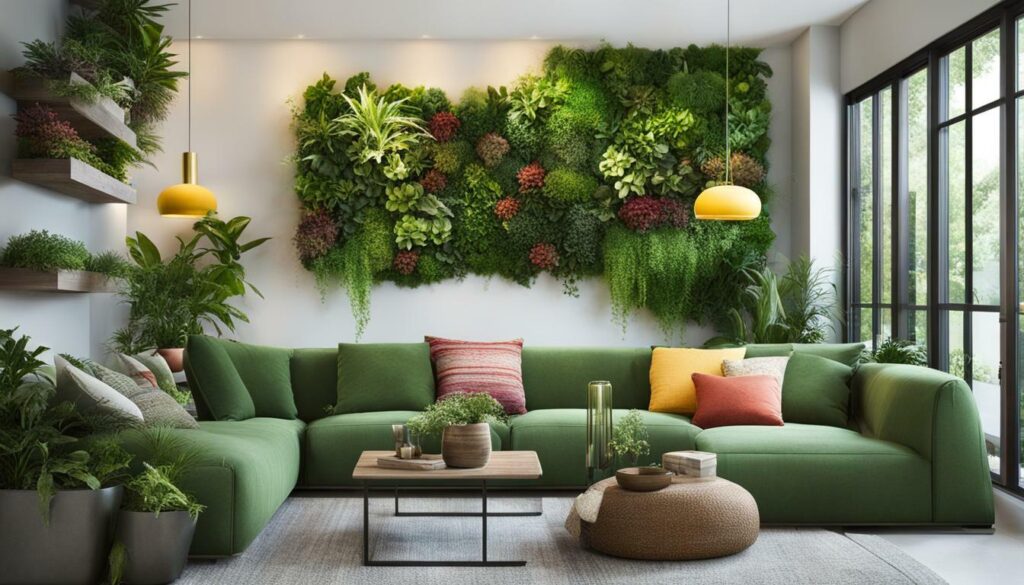
Vertical Gardens in Small Spaces
Even with limited space, you can still enjoy the benefits of a vertical garden. Discover how vertical gardening can thrive in small spaces and bring greenery to urban environments.
Vertical gardens, also known as “green walls” or “plant walls,” are a popular choice among gardeners who want to maximize their gardening potential in small spaces. Whether you have a small yard or a bare wall that needs a makeover, building a vertical garden can enhance your outdoor space. These gardens utilize vertical space that would otherwise go unused, making them ideal for balconies, fences, or indoor areas. You can grow a variety of plants, including herbs, vegetables, and flowers, creating a focal point and improving air quality.
When planning your vertical garden, it is important to choose the right location, containers, and plants. Consider the available sunlight, wind exposure, and access to water when selecting the location for your garden. Balconies and fences are perfect spots for vertical gardens, as they provide ample sunlight and support for the plants. Select lightweight and durable containers that provide adequate space for root growth and proper drainage. Choose plants that are suitable for vertical gardening, such as herbs, trailing plants, and flowering plants, taking into account their size and growth habits.
Maintaining a vertical garden requires regular care and attention. Monitor the moisture levels of the soil and water accordingly, as vertical gardens may require more frequent watering than traditional gardens due to their unique structure. Provide essential nutrients to your plants through the use of slow-release or organic fertilizers. Regular pruning is also necessary to promote healthy growth and prevent overcrowding. Remove dead or wilted leaves and trim overgrown branches to maintain the aesthetics and health of your vertical garden.
| Benefits of Vertical Garden Building | How to Plan Your Vertical Garden | How to Maintain Your Vertical Garden | Steps to Building a Vertical Garden |
|---|---|---|---|
|
|
|
|
By following these tips and techniques, you can create a thriving vertical garden in small spaces. Whether you have a balcony, a small yard, or even just a bare wall, vertical gardening allows you to bring greenery and beauty to urban environments. Enjoy the benefits of a vibrant and flourishing oasis with a vertical garden that maximizes space and creates a visually appealing green space.
Vertical Garden Inspiration
Looking for inspiration for your vertical garden? Check out some creative ideas and design options to get your imagination flowing:
- Living Walls: Create a dramatic statement by covering an entire wall with lush vegetation.
- Outdoor Installations: Utilize fences, trellises, or arbors to add vertical growing space.
- Unique Configurations: Experiment with different shapes and patterns to create a customized vertical garden.
Remember, even in small spaces, vertical gardens can transform your surroundings and bring the beauty of nature into your daily life. Start planning and building your own vertical garden today!
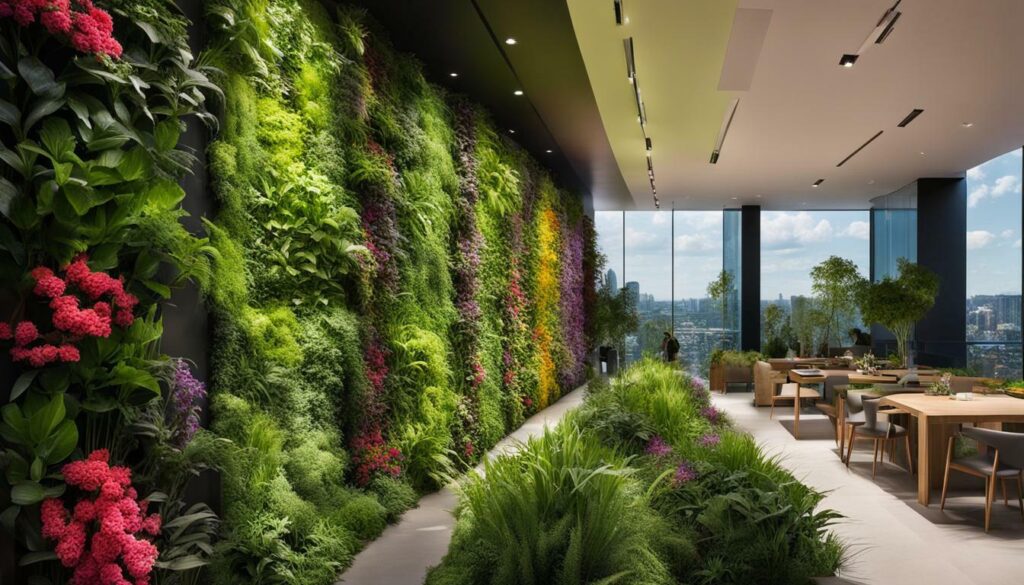
“The Varden™ Vertical Garden makes gardening accessible to everyone! No matter how much space is available or your level of skill, you can have a vertical garden that’s one-of-a-kind and ALL yours.” – The Varden™ Vertical Garden
Sustainable Practices in Vertical Gardening
Incorporating sustainable practices into your vertical gardening endeavors can not only benefit the environment but also contribute to the overall success and longevity of your green space. By adopting eco-friendly techniques and utilizing recycled materials, you can create a sustainable vertical garden that supports a healthy ecosystem.
Benefits of Sustainable Vertical Gardening
When practicing sustainable vertical gardening, you are minimizing the use of harmful chemicals, reducing waste, and promoting biodiversity. By avoiding chemical pesticides and fertilizers, you can prevent soil and water pollution, ensuring the health and well-being of your plants and the surrounding environment. Additionally, sustainable practices help create a habitat for beneficial insects and pollinators, contributing to the overall balance of your garden.
“Sustainable vertical gardening allows us to grow food in a way that is good for the planet. It’s a win-win situation where we can enjoy fresh, homegrown produce while minimizing our impact on the environment,” says John Green, a sustainable gardening enthusiast.
Using Recycled Materials
One of the key aspects of sustainable vertical gardening is the use of recycled materials. Instead of purchasing new containers or vertical garden systems, consider repurposing items such as old pallets, wooden crates, or even plastic bottles. These materials not only reduce waste but also add a unique and creative touch to your vertical garden design.
“I love finding creative ways to repurpose materials for my vertical garden. It’s not only cost-effective but also adds character to my outdoor space,” shares Jane Smith, a DIY gardener.
| Recycled Materials for Vertical Gardening | Benefits |
|---|---|
| Old Pallets | Provides vertical structure with built-in planter slots |
| Wooden Crates | Allows for easy customization and mobility |
| Plastic Bottles | Cost-effective and ideal for small plant varieties |
Practicing Eco-Friendly Techniques
In addition to using recycled materials, there are several eco-friendly techniques that can be implemented in your sustainable vertical garden. Here are a few examples:
- Composting: Utilize kitchen scraps and plant waste to create nutrient-rich compost for your garden.
- Rainwater Harvesting: Collect rainwater in barrels or other containers to reduce water consumption and reliance on treated water.
- Natural Pest Control: Encourage beneficial insects and birds to control pests naturally without the use of harmful chemicals.
- Mulching: Apply a layer of organic mulch around your plants to conserve moisture and suppress weeds.
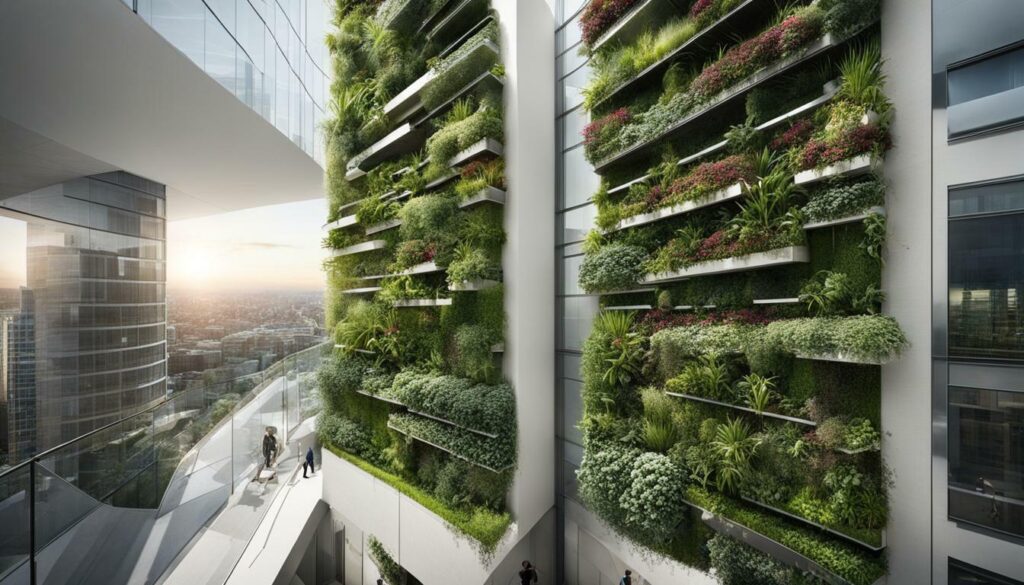
By implementing these sustainable practices, you can create a thriving vertical garden that not only enhances your living space but also contributes to a greener and more sustainable future.
Vertical Garden Maintenance Tips
Beyond regular maintenance, here are some additional tips to help you keep your vertical garden in optimal condition and address any potential challenges that may arise.
1. Watering:
- Monitor the moisture levels of the soil and water accordingly. Depending on the vertical garden wall and its environmental conditions, you may need to water more frequently than traditional gardens.
- Consider using a drip irrigation system to ensure consistent and thorough watering.
2. Fertilizing:
- Provide essential nutrients to your plants by applying a slow-release or organic fertilizer.
- Regularly check the nutrient levels of your soil and adjust fertilization accordingly.
3. Pruning:
- Help promote healthy growth by pruning your plants regularly.
- Remove dead or wilted leaves and trim overgrown branches to prevent overcrowding and maximize air circulation.
4. Pest Control:
- Keep an eye out for common pests such as aphids, mealybugs, and spider mites.
- Use natural pest control methods whenever possible, such as introducing beneficial insects or using organic insecticides.
5. Nutrient Management:
- Regularly check the nutrient levels of your soil and make any necessary adjustments.
- Consider using organic compost or compost tea to naturally enrich the soil and provide essential nutrients.
By following these maintenance tips, you can ensure the health and longevity of your vertical garden. Remember to regularly assess the condition of your plants, address any issues promptly, and enjoy the beauty and benefits of your lush green space!
Vertical Garden Maintenance Table
| Maintenance Task | Frequency |
|---|---|
| Watering | Monitor soil moisture daily and water as needed |
| Fertilizing | Apply slow-release or organic fertilizer every 4-6 weeks |
| Pruning | Regularly check for overgrown branches or dead leaves and prune as necessary |
| Pest Control | Monitor for pests regularly and take appropriate action if infestation occurs |
| Nutrient Management | Check soil nutrient levels annually and amend as needed |
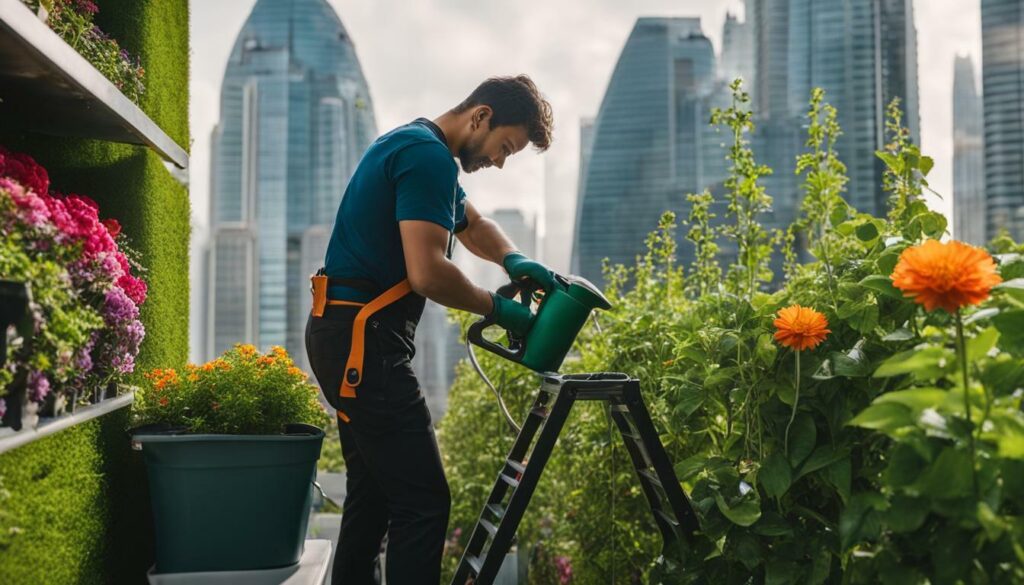
Vertical Garden Ideas for Inspiration
Looking for inspiration for your vertical garden? Explore these stunning and creative ideas to spark your imagination and elevate your green space.
1. Living Wall Art: Transform your vertical garden into a work of art by arranging plants in a visually appealing pattern or design. Consider using different shades of green, contrasting textures, and pops of color to create a captivating living masterpiece.
2. Cascading Foliage: Create a lush and vibrant display by allowing trailing plants to cascade down from your vertical garden. Choose plants with long, flowing vines such as English ivy or creeping fig to add a touch of whimsy and movement to your green space.
3. Herb Haven: Design a vertical herb garden that not only enhances the aesthetics of your outdoor space but also provides fresh herbs for your culinary creations. Utilize tiered planters or individual pockets to grow a variety of herbs like basil, mint, rosemary, and thyme.
4. Succulent Showcase: Showcase the beauty of succulents by creating a vertical garden dedicated to these low-maintenance plants. Mix and match different varieties of succulents with varying colors, shapes, and textures to create a captivating display that thrives in both indoor and outdoor environments.
5. Edible Wall: Take your vertical garden to the next level by growing edible plants and vegetables. From lettuces and strawberries to cherry tomatoes and peppers, create a vertical edible wall that not only provides fresh produce but also adds a touch of greenery to your outdoor space.
Table: Vertical Garden Ideas
| Idea | Description |
|---|---|
| Living Wall Art | Create a visually stunning living masterpiece by arranging plants in an artistic pattern or design. |
| Cascading Foliage | Add movement and whimsy to your vertical garden by allowing trailing plants to cascade down. |
| Herb Haven | Grow a variety of herbs in your vertical garden for both culinary and aesthetic purposes. |
| Succulent Showcase | Showcase the beauty of low-maintenance succulents with varying colors, shapes, and textures. |
| Edible Wall | Create a vertical garden that provides fresh produce, such as lettuces, strawberries, and tomatoes. |
Remember, these ideas are just the beginning. Let your creativity bloom and customize your vertical garden to suit your preferences and style. With a little imagination and the right plants, you can transform any space into a vibrant and thriving green oasis.

Conclusion
Premier vertical garden supply plays a crucial role in transforming ordinary spaces into extraordinary green environments, promoting green living, and creating vibrant spaces for everyone to enjoy. Vertical gardens have become increasingly popular among gardeners looking to maximize their gardening space and add visual interest to small areas. With the right planning, maintenance, and choice of plants and containers, anyone can create and maintain a beautiful vertical garden.
Vertical gardens offer numerous benefits, including maximizing vertical space, improving air quality, reducing noise pollution, and creating a focal point in any space. By utilizing vertical garden systems such as the Varden™ vertical garden or the GreenStalk Original Vertical Planter, gardeners can grow a wide variety of plants, from herbs and vegetables to flowers, in both indoor and outdoor environments.
When planning a vertical garden, it is important to choose the right location, considering factors such as sunlight, wind exposure, and access to water. Selecting lightweight and durable containers with proper drainage is essential for the success of the garden. Careful consideration should also be given to the choice of plants, ensuring they are suitable for vertical gardening and promoting optimal growth.
Maintaining a vertical garden requires regular care and attention. Proper watering techniques, fertilizing, and pruning are essential for the health and vitality of the plants. By following maintenance tips and troubleshooting advice, gardeners can address common issues and ensure the long-term success of their vertical gardens.
Building a vertical garden can be a rewarding DIY project for any gardener. By following a step-by-step guide and using materials such as wainscoting panels, VELCRO® Brand ALFA-LOK® Fasteners, and planter boxes, gardeners can create a vertical garden that fits their space and design preferences. The possibilities for vertical garden designs are endless, from living walls to outdoor installations, allowing for creativity and customization.
Vertical gardens are especially beneficial in small spaces, such as urban environments and balconies, where traditional gardening may be limited. They offer a solution for urban dwellers to grow their own food and enjoy the beauty of plants even with limited space. Additionally, practicing sustainable gardening practices, such as using recycled materials and promoting long-term ecological sustainability, is essential for creating a greener and more sustainable environment.
In conclusion, premier vertical garden supply is essential for creating top-notch green spaces and fostering vibrant environments. Whether you are a beginner gardener or an experienced green thumb, vertical gardens provide a unique and innovative way to bring nature into your surroundings and enjoy the benefits of green living.
How Can I Use Premier Vertical Garden Supply to Create Urban Green Spaces for Vegetables?
Create vibrant urban green spaces with Premier Vertical Garden Supply. Transform bland cityscapes with innovative urban vertical veg garden ideas. Utilize limited space to grow fresh vegetables and herbs. Elevate the aesthetic appeal of concrete jungles while promoting sustainable living. Premier Vertical Garden Supply offers the tools to bring urban greenery to life.
FAQ
Q: What is a vertical garden?
A: A vertical garden, also known as a green wall or plant wall, is a garden that maximizes vertical space by growing plants vertically on walls or other vertical structures.
Q: How do vertical gardens benefit outdoor spaces?
A: Vertical gardens enhance outdoor spaces by adding visual interest, maximizing limited space, improving air quality, and reducing noise pollution.
Q: What factors should I consider when planning a vertical garden?
A: When planning a vertical garden, consider the available sunlight, wind exposure, access to water, and choose containers that provide adequate space for root growth and proper drainage.
Q: How do I maintain a vertical garden?
A: Regular watering, fertilizing, and pruning are essential for maintaining a healthy vertical garden. Monitor soil moisture levels, provide essential nutrients, and trim plants regularly to promote healthy growth.
Q: What materials do I need to build a vertical garden?
A: To build a vertical garden, you’ll need a wainscoting panel or lumber to frame it, VELCRO® Brand ALFA-LOK® Fasteners, and planter boxes. Clean the surfaces, install the frame, attach the planters, and plant your garden.
Q: How do I choose the right vertical garden system?
A: Consider factors such as size, materials, and functionality when choosing a vertical garden system. Take into account your available space and desired design aesthetic.
Q: Can vertical gardens be created in small spaces?
A: Yes, vertical gardens are perfect for small spaces like balconies and urban environments. They allow you to maximize limited areas and grow a variety of plants.
Q: What sustainable practices can be incorporated into vertical gardening?
A: Sustainable practices in vertical gardening include using recycled materials, practicing eco-friendly techniques, and promoting long-term ecological sustainability.
Q: How do I troubleshoot common issues with vertical gardens?
A: Common issues with vertical gardens include pest control, managing nutrient levels, and addressing plant diseases. Regular monitoring and proactive care can help mitigate problems.
Q: Where can I find inspiration for vertical garden designs?
A: There are many sources of inspiration for vertical garden designs, including online platforms, gardening magazines, and visiting public gardens or installations. Get creative with unique configurations and installations.

